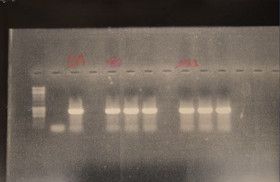The most common bacterial disease for apple and pear during spring is fire blight. Fire blight is one the most common and destructive diseases of apple and pear, which is caused by bacteria Erwinia amylovora. The name” Fire Blight” comes from the appearance of the diseased plant tissue, which looks as though it had been scorched by fire. Usually, twig shoot and blossom start showing symptoms in the spring. Blossoms will first be water soaked and grayish green in appearance, and then turn brown or even black. Twig blight starts at the tips of shoots, and turns darker, with disease development. Shoot symptoms develops rapidly. Leaves on the diseased shoot become fully, necrotic in a short period of time, thus giving the tree a burnt appearance. The end of the branch may resemble an upside down “J” or "shepherds crook", a distinctive symptom of fire blight (Fig.1). Under high humid conditions, milky droplets of bacterial ooze, containing millions of Erwinia amylovora, may be observed from diseased plant tissue
(Fig.2 and 3).
 |
|
Fig.1 Diseased pear branch showing upside down "J" symptoms
|
 |
| Fig.2 Bacterial ooze from diseased leaves. |
 |
| Fig.3 Bacterial ooze on fruit |
Once we receive a suspicious fire blight sample, the first step is to confirm that it is a bacterial disease. The bacterial ooze test is the simplest and quickest way to differentiate bacterial disease from other problems. If the symptoms are due to a bacterial disease, bacterial streaming or "ooze" can be seen from a cross section of a petiole under a microscope(Fig.3).
 |
|
Fig.4 Bacteria streaming observed
from cross section of leaf petiole under the microscope.
|
After the ooze test,
we can isolate the bacteria from the diseased plant material. The key to successfully harvesting bacteria from the affected area on the plant
is to select freshly infected tissue. Most of the time, it’s hard to isolate
pathogenic bacteria from dried out samples. Petioles, especially those that are recently infected and still
soft, are usually the best area to recover Erwina amylovora from the affected
plant. The next step is to observe the bacterial colonies that grow on media from isolation.
Bacterial colonies suspected to be Erwinia
amylovora in culture can be selected for further testing to determine the species of the isolated bacteria. The combination of PCR
amplification and electrophoresis is an accurate method to confirm bacterial
species on the molecular level. A bacterial isolate, which has been confirmed as Erwinia amylovora will be used as
positive control. This will provide a reference for the bacterial isolates taken from sample of unknown bacteria. Sample isolates
with PCR products that show the same bright band as the positive control will be
confirmed to be Erwinia amylovora (Fig. 5).
For further information on fire blight, you can refer to the following links:
http://hyg.ipm.illinois.edu/article.php?id=290
http://hyg.ipm.illinois.edu/article.php?id=349
http://hyg.ipm.illinois.edu/article.php?id=490
http://hyg.ipm.illinois.edu/article.php?id=290
http://hyg.ipm.illinois.edu/article.php?id=349
http://hyg.ipm.illinois.edu/article.php?id=490


No comments:
Post a Comment
Note: Only a member of this blog may post a comment.